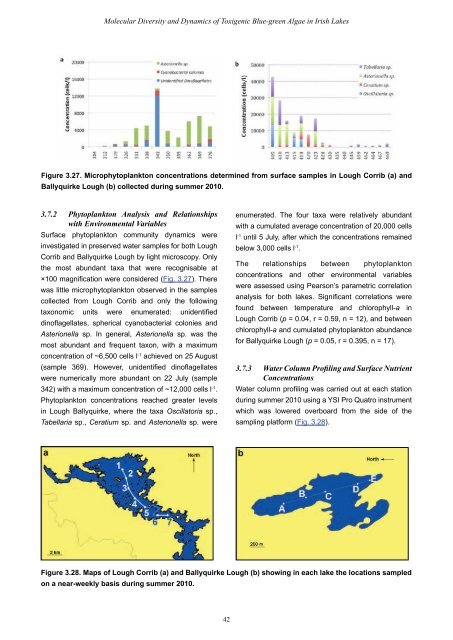STRIVE - Environmental Protection Agency
STRIVE - Environmental Protection Agency
STRIVE - Environmental Protection Agency
Create successful ePaper yourself
Turn your PDF publications into a flip-book with our unique Google optimized e-Paper software.
Molecular Diversity and Dynamics of Toxigenic Blue-green Algae in Irish Lakes<br />
Figure 3.27. Microphytoplankton concentrations determined from surface samples in Lough Corrib (a) and<br />
Ballyquirke Lough (b) collected during summer 2010.<br />
3.7.2 Phytoplankton Analysis and Relationships<br />
with <strong>Environmental</strong> Variables<br />
Surface phytoplankton community dynamics were<br />
investigated in preserved water samples for both Lough<br />
Corrib and Ballyquirke Lough by light microscopy. Only<br />
the most abundant taxa that were recognisable at<br />
×100 magnification were considered (Fig. 3.27). There<br />
was little microphytoplankton observed in the samples<br />
collected from Lough Corrib and only the following<br />
taxonomic units were enumerated: unidentified<br />
dinoflagellates, spherical cyanobacterial colonies and<br />
Asterionella sp. In general, Asterionella sp. was the<br />
most abundant and frequent taxon, with a maximum<br />
concentration of ~6,500 cells l-1 achieved on 25 August<br />
(sample 369). However, unidentified dinoflagellates<br />
were numerically more abundant on 22 July (sample<br />
342) with a maximum concentration of ~12,000 cells l-1 .<br />
Phytoplankton concentrations reached greater levels<br />
in Lough Ballyquirke, where the taxa Oscillatoria sp.,<br />
Tabellaria sp., Ceratium sp. and Asterionella sp. were<br />
42<br />
enumerated. The four taxa were relatively abundant<br />
with a cumulated average concentration of 20,000 cells<br />
l-1 until 5 July, after which the concentrations remained<br />
below 3,000 cells l-1 .<br />
The relationships between phytoplankton<br />
concentrations and other environmental variables<br />
were assessed using Pearson’s parametric correlation<br />
analysis for both lakes. Significant correlations were<br />
found between temperature and chlorophyll-a in<br />
Lough Corrib (p = 0.04, r = 0.59, n = 12), and between<br />
chlorophyll-a and cumulated phytoplankton abundance<br />
for Ballyquirke Lough (p = 0.05, r = 0.395, n = 17).<br />
3.7.3 Water Column Profiling and Surface Nutrient<br />
Concentrations<br />
Water column profiling was carried out at each station<br />
during summer 2010 using a YSI Pro Quatro instrument<br />
which was lowered overboard from the side of the<br />
sampling platform (Fig. 3.28).<br />
Figure 3.28. Maps of Lough Corrib (a) and Ballyquirke Lough (b) showing in each lake the locations sampled<br />
on a near-weekly basis during summer 2010.

















